Another Timbre TimHarrisonbre
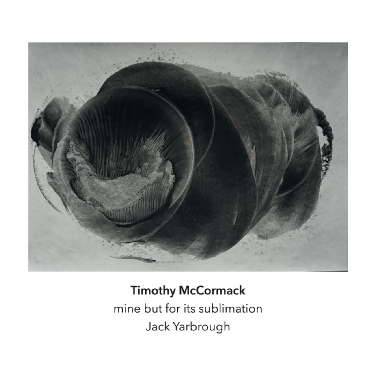
at239 Timothy McCormack
‘mine but for its sublimation’
A 60-minute solo work for piano, played by Jack Yarbrough
Interview with Timothy McCormack
First could you tell us about the piece. How did it come about, and have you written long piano solos before?
I have written long solo pieces before - for a number of years now my work has operated on a certain expansive order of form and time - though never a piano solo before this one. In fact, I had avoided the instrument very intentionally, until I discovered a strange chord. Between 2012-2016 I wrote a few chamber pieces that included piano, and in each of them, this same chord found its way in. But I resisted whatever it was trying to tell me, as at the time I believed my work to speak only a language of lines, not of points; of unbroken sounds that have the capacity to be morphed and modulated (in timbre, dynamics, degrees of noise, etc…) smoothly and continuously. So I didn’t believe the piano had much to offer me, or I was afraid of confronting what it might do to my music if I did. Secondly, at the time, I simply did not think that I was interested in tone or interval or harmony; I was far more interested in noise and morphology. So the fact that a certain chord seemed so compelling to some unvisited part of my brain disrupted what I thought was fundamentally the identity of my music. But eventually, with some encouragement of friends and collaborators, this chord brought forth the possibility of a piano solo. But it still took some time to accept the intervention.
So it started with a chord, but it took the COVID pandemic to bring me to actually start writing this piece. It was a very spontaneous decision to actually commit to it, made months into the pandemic, when we were all trying new things. Some of us started baking sourdough bread; I wrote a piano solo.
I had intended for this piece to be a small side-project, but as I worked on it, and as I started to grasp exactly what was happening to my music through this piece, it eventually became the sole focus of an entire year of composition. I had been working on the piece for about a month before I realized that I was really writing this piece for Jack Yarbrough. The heightened wager the piece places on touch, on affect, but also on form; on sensitivity to mechanism and balance in one register of the instrument versus in another… the piece, or what it was shaping up to be, was exactly mapped onto Jack’s very idiosyncratic and exacting and sensitive playing. Jack’s intervention and the nature of our collaboration heightened the sense that what was happening here was actually rather quite heavy and devastating. We went there together, we discovered this place together. It was a situation of total trust and mutual pushing and learning.
In the end, mine but for its sublimation, and Jack Yarbrough, changed my music. I was a different person before writing this piece than I was after. By embracing the piano as such (in that its vernacular is one of points rather than lines, of tone rather than of noise) I took risks I never had before, and I felt more in communion with pure form than I had ever felt before within a compositional process.
The piece obviously uses a lot of repetition, and a good deal of long resonance. Is that typical of your music?
That there is repetition is objectively true. However, it does not feel like repetition to me - upon reading the question I had to reflect as to whether there was any repetition in the piece at all, before immediately realizing that, yes, it’s all over the place. But it is never repetition as such; it is always a sleight of hand at service to formal and morphological change. The piece employs repetition so as to covertly enact development and transformation into other spaces. For example, the very beginning of the piece is perhaps its most discretely repetitive. However, the repetitions are on an extremely local level: it is either this-or-that, low C-sharp or high D-sharp (always with a diatonic cluster in between). It is not a figure or a gesture that is being repeated, it is only a vacillation between two points. So the listener’s attention is drawn to this local teetering; meanwhile, eventually, within this wavering pulse the repetition establishes, changes begin to happen, and things begin to drift upwards. We are maybe aware of that, but it subtly brings us to a register and a behavior that is eventually very different from where we began. The discrete repetitions are washed out, but we cannot place when that happened. The entire piece operates through these formal mechanisms: either baiting us with local-level microvariation between impulses so as to gradually, unobtrusively bend the material elsewhere on a more global level, or, sometimes, devastatingly, to lull us into a sustained state only to encounter a moment of conclusive and sudden severing of that state into the next. But there is always a connection, a bridge between these states; something always resonates through a process or a severing.
Which brings us to the second part of your question: resonance. Resonance was part of my music before this piece insofar as it is a mechanism of saturation. However, resonance as such - as something that decays but also blooms within that decay; as something that is distinct from but follows from attack, and is given space to be attended to by a listener - this is new for me. My work before this piece was much more dependent on sustain. And while mine but for its sublimation finds its way to sustained states, it is overwhelmingly about resonance, as well as the idea that attack and touch are the provenance of resonance. We hear this in the piece’s harnessing of register. For more than half of the piece, material is kept in very delineated registeral vectors: First in the middle/upper-middle, then in the icy highest register, then a brief return to the middle (somewhat lower) so as to pivot into the depths. Each of these spaces has a completely distinct behavior of resonance, and the piece induces our ears into attending to each space as a distinct and unique vibratory sensation before establishing a counterpoint between these resonant spaces.
For the pianist, the resonating space is an extremely vulnerable place. There is literally nowhere to hide. The conditioning of that resonance can only occur before the resonance, through the intention brought to an attack. We never touch resonance; we only touch the attack, and the instrument answers with resonance. One’s fingers initiate an attack, but in the resonance is only one’s fingerprint. It is so vulnerable to not be able to change a thing, to accept what has happened and to sit with that throughout a decay. This is why I realized that I was actually writing this piece for Jack Yarbrough: he has a relationship with touch that I have never quite encountered before, and I think that’s because he has developed a deep relationship with the resonance of the piano, and with the piano as agentic, generous, responsive collaborator.
What about the title? What does this refer to, and how does it relate to the music itself?
The ‘sublimation’ of the title refers both to transference of energy in sound production, as well as to an erotics of form enacted by the piece over its duration. ‘Sublimation’ as the passing of matter from a solid state directly into a vaporous state, which addresses my previous statements on resonance. Through the mediating agent of the piano itself, the performer’s attack is transferred immediately into resonance; their touch immediately into vibration. In idiomatic playing, one touches the piano, but never its sound; your fingers on the keys, but only ever one’s fingerprints in the sound. Therefore, the sound I generate on a piano is only ever mine but for its sublimation into resonance and vibration. The entire piece is a negotiation of this fact, and it takes it further and further into situations in which this proposition becomes problematized. The first half has the performer playing on the keys, never “touching the sound.” In one crucial and severing moment, the piece pivots into a world of harmonics, the production of which does have the performer intervening on their own attack by touching with one hand the vibrating string at specific nodal points at the moment that the other hand depresses a corresponding key: touch the string so as to condition its vibration. Beyond that, EBows creep into the room, creating vibration without the initiating attack and without the necessity of touch: a total sublimation into vapour.
But there is also a less haptic, more experiential sublimation happening at the order of form. In a number of formal maneuvers, the piece brings us to a place. The motion from one register to another; the navigation of different viscosities of harmony and texture; the various and improbable emergences of motive, melody, or harmony; in that one type of intonation is eventually contracted by another; the shifting of an earthly, counted sensation of time to a more saturating, subsuming sense of time; etc… The piece is a delicate but assured balance of proportion and event which, I hope, induces a state of sunken attention in the listener. There is an inevitability to where we arrive at any given moment, but I don’t believe any of these arrivals are particularly anticipated. The listener submits to the form of the piece, and this submission is a powerful and intense state of attention to find ourselves brought to. One listener shared their experience thusly: “I want to be this piece; or I want the piece to happen to me; I want to be the piano.” And this is what I mean by an erotics of form; a sonic and formal discourse that induces in the listener a desire not to simply listen but to be the thing itself. Listening as submission as inscendence: to sink into a thing, to nest, burrow, and be subsumed. This experience is ours, but for its sublimation. It is vibrations & resonances in space over time: we cannot touch it (the sound, the experience); we can only desire towards it. I like accessing this space, but its provenance is ultimately not sound, but form. Sound cannot touch form; it can only articulate it.
Can you tell us about your background in music; where you studied, and what stands out for you in what you've done previously?
I started composing when I was perhaps around 13 years old as a result of learning instruments. I had already started taking lessons in or teaching myself percussion, flute, and (appropriately) piano, and I think the compulsion to write for these instruments was a natural extension of learning them. Before finishing high school, I would also learn guitar, oboe, and bassoon, the last of these somehow becoming my primary instrument. I’m not sure I would have started composing if I had just stuck to one instrument.
I did my undergrad at Oberlin Conservatory, after which I went on to Huddersfield University for an MPhil, and finally my PhD at Harvard. After Harvard, I joined the composition faculty at Boston Conservatory, and now I’m at UCSD. I add these because through teaching and working with the young composers at these institutions, I learned so much and my music developed exponentially. mine but for its sublimation was written while teaching at BoCo (and while Jack Yarbrough was there as a masters student in contemporary performance); While the piece would not have been possible without my PhD experience, I also absolutely could not have written it during my PhD. It was only after my PhD that I learned how to be flexible enough with my own project to create something like this piano solo. Effectively, it was while teaching that I learned not to confuse material for identity; suddenly anything had potential and relevance: that aforementioned chord & all its implications, not to mention the pivotal triadic moment midway through the piece. (This strange chord that I keep on referencing? It’s the chord at roughly 18 minutes into this recording, which the piece gets stuck on for the following several minutes. Listeners of this disc will have plenty of time to consider it as I’ve considered it…)
The throughline throughout most if not all of my work from Oberlin until now is the idea of (or what would eventually articulate itself as the idea of) physicality. At Oberlin, this was mainly evident in the visceral energy and frenetic, thorny gestural language of both the music I wrote but also of the music I was excited about. Discovering the music of Helmut Lachenmann and Brian Ferneyhough and Richard Barrett was huge for me at the time, and it was through parroting their gestural and contrapuntal language that I first started to value the sense of physical energy being evident not only in performance but somehow in the sound itself. At Huddersfield, I researched physicality as intersecting with instrumental mechanism; how consideration of these things could become the basis for a sonic sensibility. Energy became tactility. I considered sound to be matter, to have mass. Interventions in painting (Gerard Richter) and dance (William Forsythe) were particularly important, but so were my performer collaborators, as they brought me closer to their instruments. During my PhD, my music slowly began to chill out, and physicality no longer necessarily meant gesturality. I searched for some sort of projection of physicality (which up to this point had mainly conditioned material) upon form: timescales of pieces expanded and a certain dark hermeticism replaced the former freneticism. Tatility became viscosity. Now I’m in some strange place of abundance where the idea of physicality is so elemental, so sunken into how I think about sound and time, that it’s there, palpable, but completely undemonstrative. My work now requires performers to access a far more centered, withdrawn, private communion with their own bodies, and with that of their instruments, and with those of their ensemble collaborators. It’s a heightened, acute, intense state of physicality and proprioception for the musician to produce and shape and maintain the sounds I’m asking them to generate (and also the forms I’m constructing), though this physicality is practically invisible to an audience member. Only through a certain charge in the sound does it communicate itself. Viscosity has become vulnerability.
I'm very interested in what you said earlier, about how mine but for its sublimation has given you space to explore interval and harmony more than you had previously. In a way that reflects the shifts in my own tastes over the past few years, and I wondered if you could say more about it? Do you see it as part of a wider re-emphasis in contemporary music more generally?
I do think there’s some sort of shift, or a confluence of several threads that are in the air, that’s happened with those who are interested in being receptive to it which has led more composers to explore interval and harmony in idiosyncratic but also more plainspoken ways than in the past (but of course: whose past?). When I was an undergraduate, so much discursive air was given to “tonality vs atonality,” as if it was an episode of Celebrity Death Match. What a waste of time, because these are both systems that may or may not have anything to teach you about your music. Eventually I realized that people don’t really know what these things are, and most of the time they just mean “triadic chords” and “minor seconds.” It’s far more interesting and productive to simply think of interval, and to think of a discourse amongst intervals that can emerge over time. Consonance is useful; dissonance is useful. Work with these things long enough and eventually it’s not so clear when one is one vs the other. And that’s form: creating a context for something to be perceived as something.
Also, for me, tone is inextricable from timbre, which means that it is inextricable from noise. It was only when I started working with noise that I started getting really intentional with tone and interval, though I wouldn’t acknowledge this for many years into that journey. We hear this very clearly in my music from 2014-2018 or so: I am only ever orchestrating noise that has veiled, sunken, but luminous tone buried deep within it, and I am only ever presenting tone which is encrusted with noise. This also is due to my focus on physicality: it’s not just this tone that I want, but this tone as produced in this particular way, which leaks air or bow noise or something of its physical production into it. Hearing these concerns expressed in very different ways than my own by other composers has also been very inspiring. Whereas before I invoked Lachenmann and Ferneyhough and Barrett, here I might invoke Catherine Lamb and Élaine Radigue and Michelle Lou. It might also be conditioned by certain pop music that I’ve loved for much of my life: shoegaze, My Bloody Valentine, Grouper, Mount Eerie… All of these musicians bring tone and noise very close to each other, and sink very pure melodies within more hazy, viscous, abrasive textures. Listen to something for long enough and you risk thinking about it…
But ultimately, for me, I needed form to fully bring me to things like tone and interval and harmony. It relates to this journey I’ve been on from material to form, all guided by this continuing and expanding preoccupation with physicality. At one point in this journey, thinking about physicality meant that I was putting the wager heavily on material. Thinking about how our bodies connect to instruments to activate vibration and to sustain and modulate sound: this is material. Thinking about how instruments are constructed to generate vibration and connect to and respond to our bodies in certain specific ways: this is material. Building a sonic language that is all about how a sound is produced on acoustic instruments: it’s material. And while material is still extremely important for me, I now realize that I felt I needed my material to be a certain thing, to sound a certain way, to behave a certain way in order for my music to be My Music. This is what I meant when I said, above, that I was confusing material with identity. Now, material is in much greater reciprocity with considerations of form. Through form, anything is possible, because form really is experience. Form is what emerges from my own sensibility, my own listening, my own ways of processing information, my own means of relating to others. So, from that perspective, material is both inert and pluripotent, and I can use any material and give it valence and meaning through form, because form literally is a reflection of my identity and sensibility. Form, in a way, has become material, in that it’s what I’m most in communion with while composing. mine but for its sublimation was the first piece of mine to be composed in this heightened state of reciprocity with form, and in so doing, the piece led me to these strange but luminous relational places including, but not limited to, harmony and interval. I was able to invite them into my practice because form led me there and justified them, without baggage and without history, but with necessity and contingency and inevitability. The piece is, to quote Eugenie Brinkema, ”a work, then, not about form, but of form.” Despite it containing so many types of materials that I never allowed in my music before, mine but for its sublimation saw me at my most honest, vulnerable, and true.
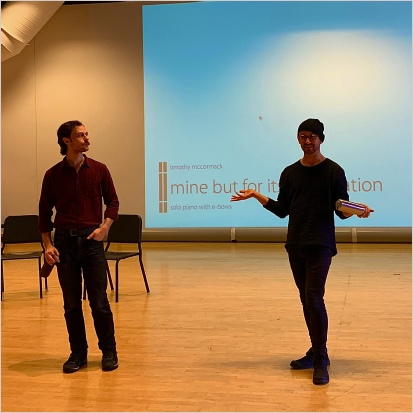
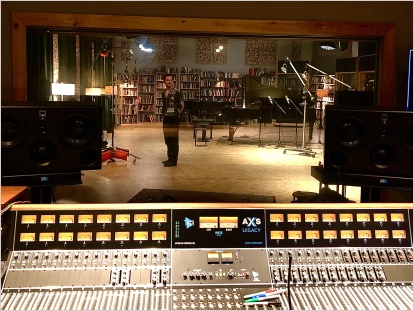
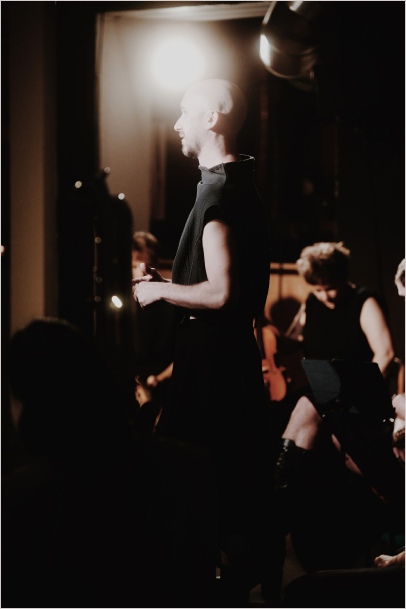
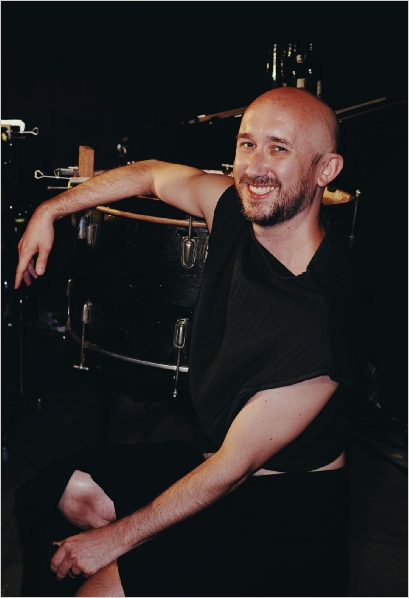
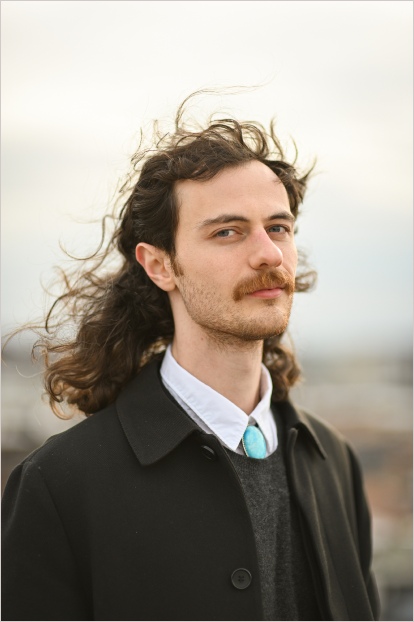
Timothy McCormack
Photo: Hang Su
Timothy McCormack
Photo: Hang Su
Jack Yarbrough
Jack Yarbrough & Timothy McCormack